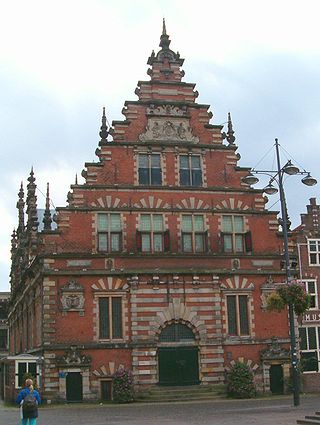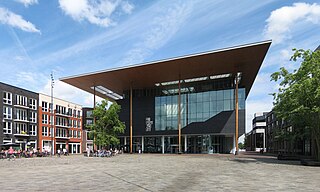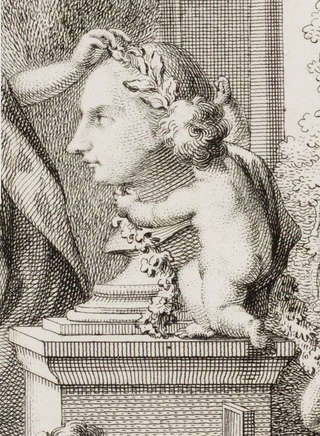
Leeuwarden is a city and municipality in Friesland, Netherlands, with a population of 123,107 (2019). It is the provincial capital and seat of the Provincial Council of Friesland.

Haarlem is a city and municipality in the Netherlands. It is the capital of the province of North Holland. Haarlem is situated at the northern edge of the Randstad, one of the more populated metropolitan areas in Europe; it is also part of the Amsterdam metropolitan area. Haarlem had a population of 162,543 in 2021.

Weesp is a city, an urban area in the municipality of Amsterdam in the province of North Holland, Netherlands. It had a population of 20,445 in 2021. It lies on the river Vecht and next to the Amsterdam–Rhine Canal in an area called the Vechtstreek. The former municipality of Weesp merged with Amsterdam on 24 March 2022.

The Frans Hals Museum is a museum located in Haarlem, the Netherlands.

The City Hall in Haarlem is the seat of the city's government. It was built in the 14th century replacing the Count's castle.

Lieven de Key was a Dutch renaissance architect in the Netherlands, mostly known today for his works in Haarlem. His style is described by Simon Schama as Mannerist.

Schloss Charlottenburg is a Baroque palace in Berlin, located in Charlottenburg, a district of the Charlottenburg-Wilmersdorf borough.

The Proveniershuis is a hofje and former schutterij on the Grote Houtstraat in Haarlem, Netherlands.

Museum van de Geest, was created in 2020 when museum Het Dolhuys, the national museum for psychiatry in Haarlem, Netherlands, which was founded in 2005 in the newly renovated former old age home known as Schoterburcht, located just across the Schotersingel from the Staten Bolwerk park, merged with the Outsider Art Museum from Amsterdam.

The Stadsbibliotheek Haarlem is a collective name for all public libraries in the Haarlem area of the Netherlands. The first public library of Haarlem opened in 1921 at the cloisters of the Haarlem City Hall where the academic library had been since 1821. The move to open its doors to the public with a public reading room was only possible after the previous occupant of the downstairs cloisters, the Frans Hals Museum, moved out in 1913 to its present location. As of 2009, there are 6 public libraries and 10 lending points, such as in hospitals.

The Princessehof Ceramics Museum is a museum of ceramics in the city of Leeuwarden in the Netherlands. The museum's name comes from one of two buildings in which it is housed: a small palace built in 1693 and later occupied by Marie Louise, dowager Princess of Orange. The other annexed building is the Papinga stins, a former stronghold from the 15th century. The museum buildings are of interest, and so are its collection of tiles, pottery, and ceramic sculpture.

The Fries Museum is a museum in Leeuwarden, Netherlands. It has won the Global Fine Art Award which is sometimes nicknamed the Museum-Oscar.

The Oval Room in the Teylers Museum was the first part of the museum that was opened in 1784. It could be entered through the garden of the fundatiehuis, the former home of Pieter Teyler van der Hulst. The building has an oval shape built around its centerpiece, a mineralogical cabinet. The Oval Room consists of two floors; the ground floor with its display cabinets and a gallery of books that connects to the Teylers Library. On top of the room, on the roof, the astronomical observatory used to be a landmark that could be seen for miles along the river Spaarne. The gallery and observatory are longer accessible to the public, though the gallery can be seen from the ground floor.

Jacob Otten Husly was an 18th-century architect from the Northern Netherlands.

The Wijnkopersgildehuis is a former guildhall in Amsterdam. The 17th-century double house is located at Koestraat 10–12, near Nieuwmarkt square. It is one of the few remaining guildhalls in Amsterdam and has the oldest known neck-gables. The building has rijksmonument status.

Groningen City Hall is the seat of government in Groningen, the Netherlands. The city council meets in a modern room downstairs, but upstairs in the former raadszaal the Gulden Boek is kept that lists the honored citizens of the town.

The Haarlem schutterij refers to a collective name for the voluntary civic guard of Haarlem, from medieval times up to the Batavian Revolution in 1794, when the guilds of Haarlem were disbanded.

The Buurkerk is a former church building in Utrecht (city), Netherlands on the Buurkerkhof. The building is the location of the Museum Speelklok, and the entrance is on the Steenweg. It is one of the medieval parish churches of Utrecht, along with the Jacobikerk, the Nicolaïkerk and the Geertekerk.

The Rechthuis is a former courthouse in the village of Bellingwolde in the Netherlands. The building with two crow-stepped gables was established in 1643 and used as a civil court for the area Bellingwolde-Blijham until 1811. The building has been a national heritage site since 1972. It is currently used as a private residence.

The Koninklijke Schouwburg is a theater in the city center of The Hague. The theater was built in 1766 and has been in use as theater since 1804. From 2017 it is one of the theaters in use by the national theater company Het Nationale Theater, but also other companies perform in the Schouwburg.






















